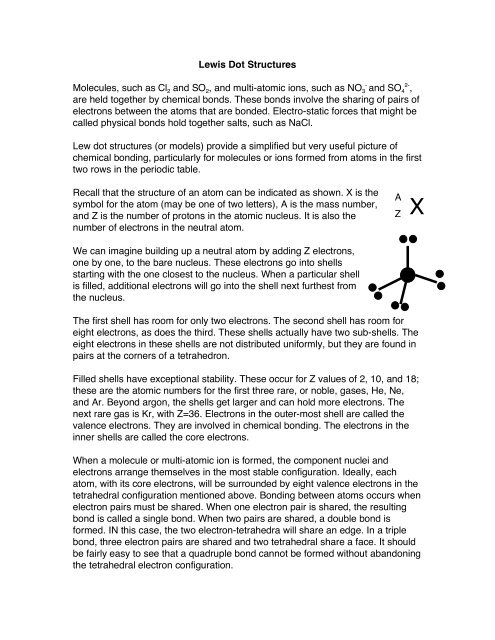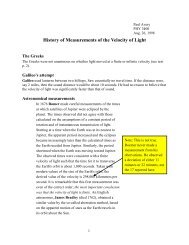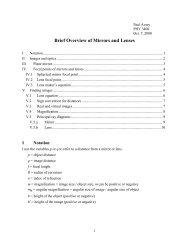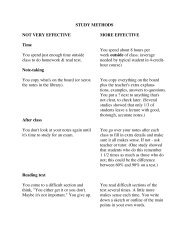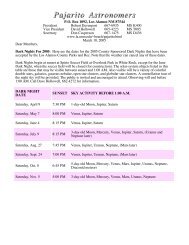Lewis Dot Structures Molecules, such as Cl2 and SO2, and multi ...
Lewis Dot Structures Molecules, such as Cl2 and SO2, and multi ...
Lewis Dot Structures Molecules, such as Cl2 and SO2, and multi ...
You also want an ePaper? Increase the reach of your titles
YUMPU automatically turns print PDFs into web optimized ePapers that Google loves.
<strong>Lewis</strong> <strong>Dot</strong> <strong>Structures</strong><br />
<strong>Molecules</strong>, <strong>such</strong> <strong>as</strong> Cl 2 <strong>and</strong> SO 2 , <strong>and</strong> <strong>multi</strong>-atomic ions, <strong>such</strong> <strong>as</strong> NO 3<br />
-<br />
<strong>and</strong> SO 4<br />
2-<br />
,<br />
are held together by chemical bonds. These bonds involve the sharing of pairs of<br />
electrons between the atoms that are bonded. Electro-static forces that might be<br />
called physical bonds hold together salts, <strong>such</strong> <strong>as</strong> NaCl.<br />
Lew dot structures (or models) provide a simplified but very useful picture of<br />
chemical bonding, particularly for molecules or ions formed from atoms in the first<br />
two rows in the periodic table.<br />
Recall that the structure of an atom can be indicated <strong>as</strong> shown. X is the<br />
symbol for the atom (may be one of two letters), A is the m<strong>as</strong>s number,<br />
<strong>and</strong> Z is the number of protons in the atomic nucleus. It is also the<br />
number of electrons in the neutral atom.<br />
We can imagine building up a neutral atom by adding Z electrons,<br />
one by one, to the bare nucleus. These electrons go into shells<br />
starting with the one closest to the nucleus. When a particular shell<br />
is filled, additional electrons will go into the shell next furthest from<br />
the nucleus.<br />
A<br />
Z<br />
X<br />
The first shell h<strong>as</strong> room for only two electrons. The second shell h<strong>as</strong> room for<br />
eight electrons, <strong>as</strong> does the third. These shells actually have two sub-shells. The<br />
eight electrons in these shells are not distributed uniformly, but they are found in<br />
pairs at the corners of a tetrahedron.<br />
Filled shells have exceptional stability. These occur for Z values of 2, 10, <strong>and</strong> 18;<br />
these are the atomic numbers for the first three rare, or noble, g<strong>as</strong>es, He, Ne,<br />
<strong>and</strong> Ar. Beyond argon, the shells get larger <strong>and</strong> can hold more electrons. The<br />
next rare g<strong>as</strong> is Kr, with Z=36. Electrons in the outer-most shell are called the<br />
valence electrons. They are involved in chemical bonding. The electrons in the<br />
inner shells are called the core electrons.<br />
When a molecule or <strong>multi</strong>-atomic ion is formed, the component nuclei <strong>and</strong><br />
electrons arrange themselves in the most stable configuration. Ideally, each<br />
atom, with its core electrons, will be surrounded by eight valence electrons in the<br />
tetrahedral configuration mentioned above. Bonding between atoms occurs when<br />
electron pairs must be shared. When one electron pair is shared, the resulting<br />
bond is called a single bond. When two pairs are shared, a double bond is<br />
formed. IN this c<strong>as</strong>e, the two electron-tetrahedra will share an edge. In a triple<br />
bond, three electron pairs are shared <strong>and</strong> two tetrahedral share a face. It should<br />
be fairly e<strong>as</strong>y to see that a quadruple bond cannot be formed without ab<strong>and</strong>oning<br />
the tetrahedral electron configuration.
The <strong>Lewis</strong> <strong>Dot</strong> Model helps us to underst<strong>and</strong> <strong>and</strong> predict what these stable<br />
configurations might be. More accurate but more complicated models are<br />
discussed in the chapters on Chemical Bonding.<br />
In the lab work, we will construct a number of <strong>Lewis</strong> <strong>Dot</strong> Models to illustrate the<br />
ide<strong>as</strong> mentioned above <strong>and</strong> to gain some familiarity with the molecules <strong>and</strong> ions<br />
we will be studying <strong>and</strong> working with.<br />
Model <strong>as</strong> many of the following <strong>as</strong> you have time for. Do at le<strong>as</strong>t four molecules<br />
<strong>and</strong> four ions. For each, draw your result in the margin <strong>and</strong> indicate the numbers<br />
of valence electrons <strong>and</strong> the numbers of single, double, <strong>and</strong> triple bonds.<br />
N 2 nitrogen<br />
2-<br />
CO 3 carbonate<br />
H 2 O water CN - cyanide<br />
NH 3 ammonia OH - hydroxide<br />
CH 4 methane<br />
-<br />
NO 3 nitrate<br />
C 2 H 4 ethylene<br />
-<br />
NO 2 nitrite<br />
C 2 H 2 acetylene<br />
2-<br />
O 2 peroxide<br />
CO 2 carbon dioxide<br />
3-<br />
PO 4 phosphate<br />
CO carbon monoxide<br />
2-<br />
SO 4 sulfate<br />
SO 2 sulfur dioxide<br />
2-<br />
SO 3 sulfite<br />
BF 3 boron trifluoride SCN - thiocyanate<br />
O 3 ozone<br />
+<br />
NH 4 ammonium<br />
N 2 O nitrous oxide H 3 O + hydronium<br />
NaCl sodium chloride<br />
BeCl 2 beryllium chloride<br />
Notes:<br />
1. <strong>Molecules</strong> or ions with the same numbers of atoms <strong>and</strong> valence electrons<br />
have the same structures. This means that the atoms could be rearranged<br />
without changing the bonding or structures. Usually, one of these<br />
rearrangements will be much more stable than the others. The re<strong>as</strong>ons for<br />
this will be discussed in a later chapter.<br />
2. Be considering the tetrahedral configuration for the eight electrons, it is<br />
possible to predict the shapes of these molecules or ions in three<br />
dimensions. Examples: H 2 O is not linear, CO 2 is linear, but SO 2 is not.<br />
NO 3<br />
-<br />
is flat but ClO 3<br />
-<br />
is not.<br />
3. In the <strong>Lewis</strong> <strong>Dot</strong> notation, the double bond is shown <strong>as</strong> X::Y. This does not<br />
imply that one pair is closer to X <strong>and</strong> the other to Y. The pairs are<br />
horizontal rather than vertical. The double bond is commonly indicated <strong>as</strong><br />
X=Y.


